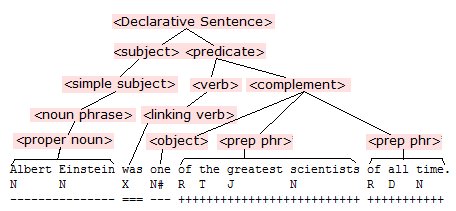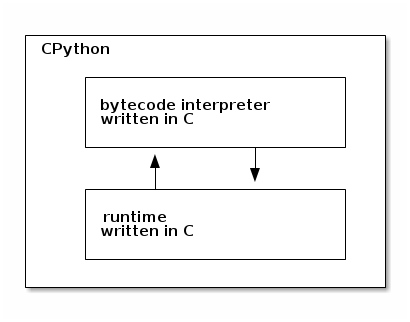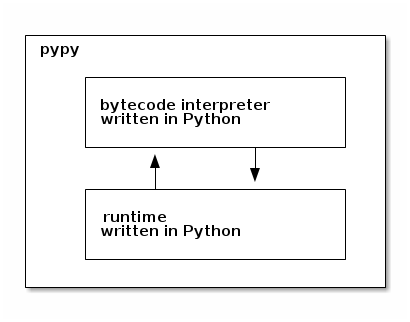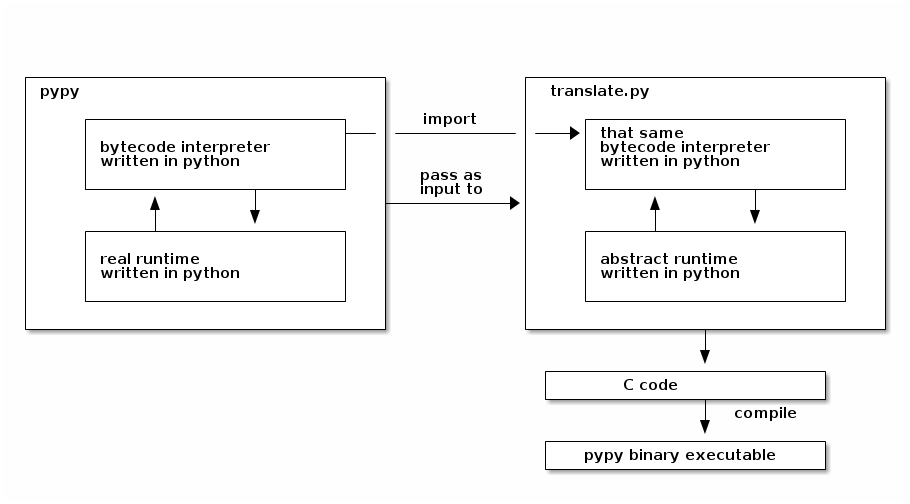pypy
how does it even?
Presented at rocpy by @ralphbean.
Slides available at http://threebean.org/presentations/pypy/

Let's talk about
pypy

caveat
emptor
- I don't really know anything about pypy.
- I do web development. It's not dark magic.
- There are people who are really into languages and compilers. I'm not one of them.
- That's the cool thing about these rocpy sessions.
if you don't know
now you know
- Maybe you've never heard of pypy
- pypy is python rewritten in python.
- It is much faster than the original python.
- It must be impossible.
_ = ( 255, lambda V ,B,c :c and Y(V*V+B,B, c -1)if(abs(V)<6)else ( 2+c-4*abs(V)**-0.4)/i ) ;v, x=1500,1000;C=range(v*x );import struct;P=struct.pack;M,\ j ='<QIIHHHH',open('M.bmp','wb').write for X in j('BM'+P(M,v*x*3+26,26,12,v,x,1,24))or C: i ,Y=_;j(P('BBB',*(lambda T:(T*80+T**9 *i-950*T **99,T*70-880*T**18+701* T **9 ,T*i**(1-T**45*2)))(sum( [ Y(0,(A%3/3.+X%v+(X/v+ A/3/3.-x/2)/1j)*2.5 /x -2.7,i)**2 for \ A in C [:9]]) /9) ) )
that thing runs
like this
$ time python mandelbrot.py
python mandelbrot.py 260.94s user 0.09s system 99% cpu 4:21.20 total$ time pypy mandelbrot.py
pypy mandelbrot.py 68.74s user 0.07s system 99% cpu 1:08.91 totalThat's 3.8 times faster.
- So, that's amazing.
- I didn't have to do anything.
- Check out http://speed.pypy.org/ for benchmarks.
- Some things are dozens of times faster.
my
mom

How would I explain this to my mom?
consider
the english language

my
daughter

How could I possibly explain this to her?
consider
liverwurst

I own a house,
and mess with stuff that I probably shouldn't

Sometimes,
breaking stuff

the best
advice

can we hack it?
yes we can!
$ hg clone https://bitbucket.org/pypy/pypy
$ cd pypyWe can run the interpreter, as written in python.
$ cd pypy/bin
$ python pypy_interactIt's super slow.
You have
to build it
What does that even mean?
$ python rpython/bin/rpython -Ojit pypy/goal/targetpypystandalone.py
That thing is rewriting pypy as c code (millions of lines of code)
So, while that's building...
RPython
is a thing
- pypy is written in RPython.
- It's called "Restricted Python", or RPython.
- It is python, but just not all of it. It is a subset of python.
- It is statically typed.
RPython
by definition
- But, what kind of subset is it?
- It is anything accepted by the pypy translation tool.
- And that is kind of squirrely.
Let's write
some RPython code
Specifically some fibonacci code.
A look
at the toolchain

A look
at the toolchain
- It is tracing and inferring types
- Think about what this means in the simple fibonacci program.
- Think about what this means in one of your real programs, including imports.
- Think about what this means for translating pypy itself - it's mind-blowing.
More
on the translator
Does the translator operate on python source, i.e. .py files?
Is there a parser for that? An AST handler? Lex, etc?
Nope
It operates on bytecode.
consider:
>>> import os >>> os.path.abspath <function abspath at 0x7f413cd39a28> >>> os.path.abspath.__code__.co_code 't\x00\x00|\x00\x00\x83\x01\x00sH\x00t\x01\x00|\x00\x00t\x02\x00\x83\x02\x00r*\x 00t\x03\x00j\x04\x00\x83\x00\x00}\x01\x00n\x0c\x00t\x03\x00j\x05\x00\x83\x00\x00 }\x01\x00t\x06\x00|\x01\x00|\x00\x00\x83\x02\x00}\x00\x00n\x00\x00t\x07\x00|\x00 \x00\x83\x01\x00S'
So,
whatever...
but the implications are crazy. Look at this. This is CPython, the one you know and love.
There's a lot more to it, but it basically boils down to this.

This is pypy
It is basically the same, but written in Python
OK, it's not really the same. There's a JIT in there, but bear with me.

Talk about
code re-use
They got to re-use the bytecode interpreter from pypy in the translation process.

pypy translates itself into C, using itself.
I'm out.
Closing
thought
The translation toolchain is the coolest part.
Then again, there are neat things in the pypy implementation itself, like the JIT which I don't understand.
FWIW, the translation toolchain allows other things to be implemented in rpython, and translated to C, like topaz.
pypy
how does it even?
Presented at rocpy by @ralphbean.
Slides available at http://threebean.org/presentations/pypy/
